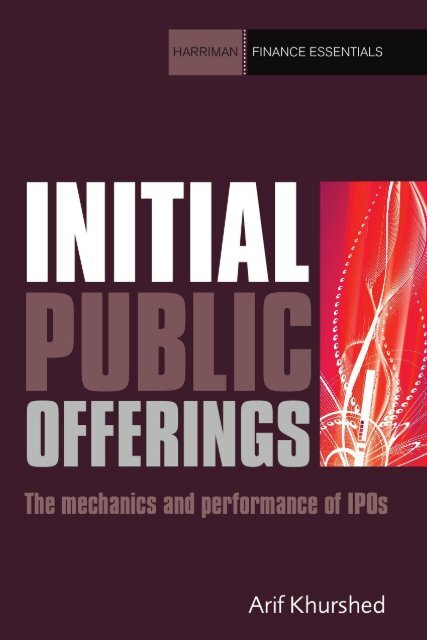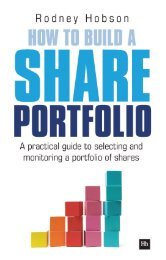Read a PDF Sample of Initial Public Offerings - Harriman House
Read a PDF Sample of Initial Public Offerings - Harriman House
Read a PDF Sample of Initial Public Offerings - Harriman House
You also want an ePaper? Increase the reach of your titles
YUMPU automatically turns print PDFs into web optimized ePapers that Google loves.
• • • • <strong>Sample</strong> • • • •
<strong>Initial</strong> <strong>Public</strong> <strong>Offerings</strong><br />
The mechanics and performance<br />
<strong>of</strong> IPOs<br />
By Arif Khurshed
HARRIMAN HOUSE LTD<br />
3A Penns Road<br />
Petersfield<br />
Hampshire<br />
GU32 2EW<br />
GREAT BRITAIN<br />
Tel: +44 (0)1730 233870<br />
Fax: +44 (0)1730 233880<br />
Email: enquiries@harriman-house.com<br />
Website: www.harriman-house.com<br />
First published in Great Britain in 2011<br />
Copyright © <strong>Harriman</strong> <strong>House</strong> Ltd<br />
The right <strong>of</strong> Arif Khurshed to be identified as Author has been asserted in accordance with the<br />
Copyright, Design and Patents Act 1988.<br />
ISBN: 978-1905641-15-4<br />
British Library Cataloguing in <strong>Public</strong>ation Data<br />
A CIP catalogue record for this book can be obtained from the British Library.<br />
All rights reserved; no part <strong>of</strong> this publication may be reproduced, stored in a retrieval system, or<br />
transmitted in any form or by any means, electronic, mechanical, photocopying, recording, or<br />
otherwise without the prior written permission <strong>of</strong> the Publisher. This book may not be lent, resold,<br />
hired out or otherwise disposed <strong>of</strong> by way <strong>of</strong> trade in any form <strong>of</strong> binding or cover other than that<br />
in which it is published without the prior written consent <strong>of</strong> the Publisher.<br />
Printed and bound by the CPI Group, Antony Rowe, Chippenham.<br />
No responsibility for loss occasioned to any person or corporate body acting or refraining to act as<br />
a result <strong>of</strong> reading material in this book can be accepted by the Publisher or by the Author.<br />
Hh<br />
<strong>Harriman</strong> <strong>House</strong>
Contents<br />
Acknowledgements<br />
About the Author<br />
Preface<br />
v<br />
vii<br />
ix<br />
Chapter 1: An Introduction to IPOs 1<br />
1.1 The life cycle <strong>of</strong> companies 3<br />
1.2 Why companies conduct IPOs 4<br />
1.3 Company preparation for an IPO 9<br />
Chapter 2: A History <strong>of</strong> IPOs 17<br />
2.1 The London Stock Exchange 19<br />
2.2 Regulatory and administrative history <strong>of</strong> UK IPOs 25<br />
2.3 A brief history <strong>of</strong> IPOs in the UK since 1945 26<br />
2.4 High-pr<strong>of</strong>ile UK and international IPOs 32<br />
Chapter 3: Mechanics <strong>of</strong> IPOs 45<br />
3.1 Methods <strong>of</strong> flotation 47<br />
3.2 The timetable <strong>of</strong> an IPO 53<br />
3.3 How IPOs are priced 59<br />
3.4 Applying for IPO shares 69<br />
3.5 How IPO shares are allocated 72<br />
3.6 Trading IPO shares 73<br />
3.7 The grey market 75<br />
5
<strong>Initial</strong> <strong>Public</strong> <strong>Offerings</strong> | Arif Khurshed<br />
Chapter 4: The Performance and Survival <strong>of</strong> IPOs 77<br />
4.1 How IPOs perform when trading in their shares commences 79<br />
4.2 The survival <strong>of</strong> IPOs 110<br />
4.3 An analysis <strong>of</strong> the performance <strong>of</strong> UK privatisation IPOs 113<br />
Chapter 5: Investing in IPOs 117<br />
5.1 Where to find information on firms planning an IPO 119<br />
5.2 The IPO prospectus 119<br />
5.3 What else to look for in an IPO firm 135<br />
5.4 Ten summary rules for IPO investment 137<br />
Bibliography 139<br />
Index 145<br />
6
Acknowledgements<br />
I would like to thank Liz Hardy <strong>of</strong> London Stock Exchange (LSE) for allowing me to<br />
cite and reproduce some material from a survey conducted by the LSE. Thank you<br />
to Jay Ritter and Silvio Vismara for their comments and input on an earlier version<br />
<strong>of</strong> the text. I also thank my family for their patience and support especially during<br />
periods <strong>of</strong> writer’s block. I dedicate this book to my wife and two children.<br />
7
About the Author<br />
Arif Khurshed completed his PhD from ICMA Centre, University <strong>of</strong> <strong>Read</strong>ing, in the<br />
year 1999 and joined Manchester Business School (MBS), University <strong>of</strong> Manchester,<br />
as a post doctoral researcher. He is a senior lecturer in the Division <strong>of</strong> Accounting &<br />
Finance, MBS.<br />
Arif has taught corporate finance for more than ten years and has been an active<br />
researcher in the field <strong>of</strong> initial public <strong>of</strong>ferings (IPOs), institutional investments and<br />
corporate governance. He has published his research in several finance journals and<br />
has contributed many book chapters. His research has been covered by the Investors<br />
Chronicle, the UK press (The Times) and the Thai press (The Nation). Arif has been<br />
an external consultant to the UK stock market regulator, the Financial Services<br />
Authority (FSA) and to the British Venture Capital Association. <strong>Initial</strong> <strong>Public</strong><br />
<strong>Offerings</strong> is his first book.<br />
9
Preface<br />
What this book covers<br />
This book is about one <strong>of</strong> the most attractive areas <strong>of</strong> investment, <strong>Initial</strong> <strong>Public</strong><br />
<strong>Offerings</strong> (IPOs), commonly referred to as new issues. Reducing an IPO to its very<br />
basics, it refers to the occasion when a company issues common stock or shares to<br />
the public for the first time. The IPO process is also known as going public, flotation<br />
and listing, and throughout this book I use these terms interchangeably.<br />
IPOs have considerable appeal since they allow investors to buy shares in exciting<br />
new companies as they make their debut on the stock exchange. In addition, there is<br />
the lure <strong>of</strong> making potentially high returns in a relatively short period <strong>of</strong> time, as<br />
quite <strong>of</strong>ten on the first day <strong>of</strong> trading the share price <strong>of</strong> these companies closes much<br />
higher than the price at which the shares were <strong>of</strong>fered to investors in the IPO.<br />
The main purpose <strong>of</strong> the book is to provide information on the mechanics and<br />
performance <strong>of</strong> IPOs. <strong>Read</strong>ers will find information on some fundamental questions<br />
related to investment in IPO markets, including the different methods <strong>of</strong> flotation,<br />
how IPOs are priced, and the performance <strong>of</strong> IPOs in the short and long term. The<br />
book also provides some information related to investing in the IPO market,<br />
including where to find information and how an IPO prospectus is structured.<br />
Who this book is for<br />
This book is for investors, academics and students who want to find out more about<br />
how IPOs are arranged and their historic performance. Directors <strong>of</strong> companies<br />
planning an IPO will also find this book helpful.<br />
11
<strong>Initial</strong> <strong>Public</strong> <strong>Offerings</strong> | Arif Khurshed<br />
How this book is structured<br />
This book is organised into the following chapters:<br />
• An Introduction to IPOs: This chapter covers some basic information on going<br />
public such as the life cycle <strong>of</strong> companies, and why and when companies go<br />
public. It also discusses how companies prepare for an IPO.<br />
• A History <strong>of</strong> IPOs: This chapter begins with a discussion <strong>of</strong> the regulatory and<br />
administrative history <strong>of</strong> UK IPOs at the London Stock Exchange (LSE). A<br />
discussion <strong>of</strong> share trading on LSE follows. The third section <strong>of</strong> the chapter<br />
provides a brief history <strong>of</strong> IPOs in the UK since 1945. In the last part <strong>of</strong> the<br />
chapter I discuss some high pr<strong>of</strong>ile UK and international IPOs.<br />
• Mechanics <strong>of</strong> IPOs: This chapter looks at the dynamics <strong>of</strong> an IPO, such as the<br />
different methods by which a firm can do an IPO on the LSE and their<br />
implications for potential investors. Information is included on how IPOs are<br />
priced, how to apply for shares and how share allocations are made in practice.<br />
There is also a look at when shares are received by investors and when can they<br />
be traded.<br />
• The Performance and Survival <strong>of</strong> IPOs: This chapter looks at what happens<br />
once a company successfully lists on the stock market. When investors buy<br />
shares in an IPO firm, they expect healthy pr<strong>of</strong>its from their investment. Are<br />
their pr<strong>of</strong>its really healthy? What happens if the investors decide not to sell their<br />
shares in the immediate after-market but to hold on to their investments for a<br />
longer period <strong>of</strong> time? Will the IPO firm survive long enough to provide a good<br />
return on investment? Questions like these are answered in this chapter using<br />
historic and current data on LSE IPOs.<br />
• Investing in IPOs: This chapter looks at where to find information on firms<br />
planning an IPO, what the IPO prospectus says about the quality <strong>of</strong> the firm,<br />
and what factors identify good or bad IPO investments.<br />
12
CHAPTER 1<br />
An Introduction to IPOs
In this chapter I start with a discussion <strong>of</strong> the life cycle <strong>of</strong> companies and how some<br />
<strong>of</strong> them move towards an IPO. The next section discusses why companies may decide<br />
to conduct an IPO and the potential disadvantages <strong>of</strong> such a decision. A discussion<br />
<strong>of</strong> how companies prepare for an IPO follows.<br />
1.1 The life cycle <strong>of</strong> companies<br />
Businesses in the private sector are started either as unincorporated or incorporated<br />
concerns. Unincorporated businesses fall into two types depending on whether there<br />
is a single owner (sole trader) or several owners (partnership). With an unincorporated<br />
business there is no legal distinction between the business and its owner(s).<br />
Incorporated businesses have a separate legal identity from their owners. Of these,<br />
the commonest form are companies limited by shares. They can be private or public<br />
limited companies. Private limited companies can only sell their shares or debentures<br />
privately but public limited companies (PLCs) can raise capital from the public at<br />
large through an IPO.<br />
Both the unincorporated and incorporated businesses are initially funded by the<br />
founder owners and as these firms grow they need more capital. The owners may<br />
first turn to their friends and family when they need additional funds. Later they may<br />
borrow from a bank either as a fixed-term loan or through an overdraft facility. When<br />
such sources are exhausted the firms may turn towards private equity providers such<br />
as business angels and venture capitalists (VCs).<br />
For those firms which do not have such an option (VCs have preferences for certain<br />
types <strong>of</strong> firms in certain industry sectors), an alternative is to list the company on a<br />
stock exchange through an IPO. Even for VC-backed firms, there may come a time<br />
when the VC would like to exit the firm in order to capitalise on its investment. On<br />
the occasion <strong>of</strong> such an exit <strong>of</strong> the VC from a firm, one <strong>of</strong> two usual methods is used<br />
– trade sales or, again, an IPO.<br />
For any firm to conduct an IPO, it has to be a public limited company (PLC). So if a<br />
firm was started as a sole trading firm, it would need to incorporate itself as a PLC<br />
before it would be allowed to go public. Figure 1.1 provides an illustration <strong>of</strong> the<br />
situation as described so far for UK private enterprise.<br />
15
<strong>Initial</strong> <strong>Public</strong> <strong>Offerings</strong> | Arif Khurshed<br />
Figure 1.1 – UK businesses in the private sector<br />
Business in the private<br />
sector<br />
Unincorporated<br />
Incorporated<br />
Sole trader<br />
Partnership<br />
Private limited<br />
company<br />
<strong>Public</strong> limited company<br />
(PLC)<br />
<strong>Initial</strong> public <strong>of</strong>fering<br />
(IPO)<br />
Not all companies choose the path <strong>of</strong> an IPO. In fact, in any country only a small<br />
fraction <strong>of</strong> firms end up doing an IPO. For example, in the UK, <strong>of</strong> the 2.1 million<br />
firms registered for VAT and/or PAYE in March 2010, only around 2700 or so are<br />
listed on the London Stock Exchange (LSE).<br />
1.2 Why companies conduct IPOs<br />
Companies might conduct an IPO for a variety <strong>of</strong> reasons. For instance, growing<br />
companies need capital for expansion. If internal sources such as retained earnings<br />
and friends and family, or external sources such as bank loans or private equity, are<br />
either unavailable or do not generate sufficient capital then usually the only option<br />
left for a firm that needs funding is to conduct an IPO.<br />
An IPO helps the company in more than one way. Through an IPO a firm can raise<br />
capital to finance its current and future capital requirements. A part <strong>of</strong> this capital<br />
can be used to retire debt by paying <strong>of</strong>f overdrafts or loans which are close to maturity.<br />
Also, once an IPO has been completed, companies can further raise capital in the<br />
future by conducting seasoned equity <strong>of</strong>ferings (called rights issues in the UK).<br />
Thirdly, companies that have conducted an IPO can expect to borrow on better terms<br />
in the market because <strong>of</strong> the better transparency surrounding the company’s business<br />
and accounts that comes from its listing on the stock exchange.<br />
16
An Introduction to IPOs | Chapter 1<br />
Another reason why firms may wish to go public is for employee compensation. A<br />
large number <strong>of</strong> firms believe that by <strong>of</strong>fering employees a formal stake (shares with<br />
a market price) in the company, they are <strong>of</strong>fering an incentive to work hard. Share<br />
ownership may also help the firm to retain high quality staff. When<br />
MoneySupermarket, conducted an IPO in July 2007, it <strong>of</strong>fered free shares to its<br />
employees. In an interview a spokeswoman for MoneySupermarket said:<br />
Indeed, one <strong>of</strong> the core reasons for the flotation is to be able to <strong>of</strong>fer the employee<br />
share schemes in respect <strong>of</strong> listed securities. This will not only allow staff to enjoy<br />
the success <strong>of</strong> the business, but will help to attract and retain employees. 1<br />
The chief executive <strong>of</strong> MoneySupermarket went on to add:<br />
Every single member <strong>of</strong> staff is getting free shares worth a minimum <strong>of</strong> £3000.<br />
Even a receptionist who has been in the business for two months. 2<br />
A similar theme was attached to The Admiral Group IPO in 2004 in which the<br />
employees had an 8% stake. Alastair Lyons, chairman <strong>of</strong> Admiral, said:<br />
Flotation is a key stage in the group’s development, enabling us to provide a<br />
public market for Admiral shares, increasing the pr<strong>of</strong>ile <strong>of</strong> the group and<br />
enabling employees to see the benefit <strong>of</strong> their work. 3<br />
There are strategic advantages that occur once an IPO has been completed. When a<br />
firm goes public, its reputation and visibility are enhanced, thus giving it a vital<br />
competitive edge over its unlisted competitors. When a firm is private, its operations<br />
are usually constrained by limited capital as potential acquirers simply do not know<br />
<strong>of</strong> the firm’s existence. A public listing makes it easier for companies to notice and<br />
evaluate the firm for potential mergers or acquisitions.<br />
Going public also has benefits for a company’s founder owners. A public listing<br />
provides a good opportunity for the entrepreneur to sell some <strong>of</strong> his or her stake in<br />
the company so as to consume some <strong>of</strong> the capital tied up in the business. An IPO is<br />
also a chance for the proprietor to reduce the risk <strong>of</strong> their investment portfolio by<br />
diversifying into a wider spread <strong>of</strong> investments.<br />
1 www.personneltoday.com<br />
2 Daily Telegraph.<br />
3 Post Magazine, 15 September 2004.<br />
17
<strong>Initial</strong> <strong>Public</strong> <strong>Offerings</strong> | Arif Khurshed<br />
Not all reasons why businesses conduct IPOs are <strong>of</strong> equal importance. In a survey <strong>of</strong><br />
firms that listed during the early 2000s, LSE found that for 71% <strong>of</strong> the firms that listed<br />
on LSE, the main reason for listing was the need to raise funds for growth. It was<br />
found that 11% <strong>of</strong> the surveyed firms mentioned enhancement <strong>of</strong> the company’s<br />
pr<strong>of</strong>ile and credibility as the main reason for their listing. A similar percentage<br />
mentioned exit <strong>of</strong> VC investors as the main reason for seeking a stock market<br />
flotation. Only 5% <strong>of</strong> the firms felt that the main reason for an IPO was to provide<br />
share options to directors and staff. Another 5% mentioned future acquisitions as<br />
the main motive for conducting an IPO.<br />
When looking at an IPO, it is important to check what the raised funds will be used<br />
for – at different times it might be best for companies to use capital in certain ways.<br />
For example, at times when the wider economy is contracting (as during the credit<br />
crunch and falling stock markets <strong>of</strong> 2007-2009), investors may not wish to invest in<br />
an IPO firm that has no good plans for growth and instead intends to use most <strong>of</strong><br />
the cash raised from the IPO to pay its debt.<br />
IPO companies that are a management buyout (MBO), or firms which have had VC<br />
backing, usually borrow money to pay a dividend to pre-IPO shareholders such as the<br />
VCs, buyout firms and banks. This borrowed money is then repaid using the proceeds<br />
<strong>of</strong> the IPO. An example <strong>of</strong> such a case is Verso Paper, which did an IPO on NYSE in<br />
May 2008. Verso mentioned in its listing prospectus that almost 99% <strong>of</strong> the proceeds <strong>of</strong><br />
the IPO would be used to pay the debt incurred in making payments to its equity holders.<br />
Similarly, RHI Entertainment, which went public on NASDAQ in June 2008, also<br />
used the funds raised to repay debt. Verso Paper and RHI Entertainment have both<br />
been poor performers when compared to other IPOs. On the first day <strong>of</strong> trading,<br />
shares <strong>of</strong> Verso Paper closed nearly 17% below their <strong>of</strong>fer price. In early January 2011,<br />
Verso’s shares were trading nearly 70% below the <strong>of</strong>fer price. RHI had problems in<br />
finding buyers for its IPO shares and its <strong>of</strong>fer price was set below the expected range.<br />
If a firm says that it is planning to use most <strong>of</strong> its proceeds from an IPO to retire debt<br />
then close attention should be paid to the company’s financial data, its business plan<br />
(once the issue proceeds have been used to pay <strong>of</strong>f the debt) and the overall growth<br />
prospects for the firm’s industry. There is more discussion on this in Chapter 5.<br />
18
An Introduction to IPOs | Chapter 1<br />
A note on primary and secondary shares<br />
In an IPO a business will typically sell two types <strong>of</strong> shares: primary and<br />
secondary. Technically there is no difference between these two types <strong>of</strong><br />
shares. The difference only lies in their source.<br />
Though the financial requirements <strong>of</strong> the business are a strong motivation for<br />
going public, the sale <strong>of</strong> existing shares (secondary shares, owned by the<br />
owners <strong>of</strong> the business) does not affect the business financially – the proceeds<br />
from the sale <strong>of</strong> secondary shares go only to the owners <strong>of</strong> the shares. It is only<br />
the sale <strong>of</strong> newly created shares (primary shares) that bring money to the firm’s<br />
accounts at the time <strong>of</strong> the IPO. As stated, most IPOs <strong>of</strong>fer a mix <strong>of</strong> both<br />
primary and secondary shares.<br />
It is important to note that this combination <strong>of</strong> primary and secondary shares<br />
differs from market to market. Jenkinson and Ljungqvist report that 67% <strong>of</strong><br />
Portuguese IPOs involve shares sold by insiders in the business only, while for<br />
Germany the proportion is 23%. 4 This means that in nearly seven out <strong>of</strong> ten<br />
IPOs in Portugal (and two out <strong>of</strong> ten in Germany) the IPO is only done in order<br />
for the entrepreneur to exit (or partially exit) from the firm. In these cases no<br />
money is raised on behalf <strong>of</strong> the firm as all the shares that are sold are secondary.<br />
By contrast, 98% <strong>of</strong> US IPOs involve at least some primary equity while 56%<br />
sell only primary equities. The average split between primary and secondary<br />
equity <strong>of</strong> the US is 85% and 15% respectively. For the UK market, Brennan<br />
and Franks report the split between primary and secondary equity to be<br />
around 54% and 46%. 5 In Finland 73% <strong>of</strong> equity sold in IPOs is primary.<br />
The mix <strong>of</strong> primary and secondary shares being sold by a firm in an IPO is<br />
usually mentioned in the listing prospectus and can be revealing. For example,<br />
if all the shares on sale only come from the existing owners – they are all<br />
secondary shares – this would be alarming as it would signal a cash in and<br />
run from the owners.<br />
4 T. J. Jenkinson and A. P. Ljungqvist, Going <strong>Public</strong>: The Theory and Evidence on How<br />
Companies Raise Equity Finance (Oxford University Press, 2001).<br />
5 M.J. Brennan and J. Franks, ‘Under-pricing, ownership and control in initial public <strong>of</strong>ferings<br />
<strong>of</strong> equity securities in the UK’, Journal <strong>of</strong> Financial Economics, 45 (1997), pp. 391-413.<br />
19
<strong>Initial</strong> <strong>Public</strong> <strong>Offerings</strong> | Arif Khurshed<br />
Disadvantages <strong>of</strong> IPOs<br />
There are disadvantages to going public, as well as benefits. When firms do an IPO,<br />
they have to adhere to strict transparency rules covering information about the<br />
company. Various aspects <strong>of</strong> the management, such as the board structure, directors’<br />
remuneration and insider dealings come under public scrutiny. Further, the listed<br />
company has to adhere to continuing obligations once it is listed in that it has to<br />
disclose price sensitive information and has to regularly file reports with the financial<br />
regulators and the stock exchange.<br />
All this costs money and time, and it also provides vital strategic information to the<br />
firm’s competitors. In the LSE survey <strong>of</strong> the early 2000s mentioned above, nearly all<br />
the surveyed companies identified certain drawbacks to being listed on the stock<br />
exchange. Primary among these drawbacks (with 61% <strong>of</strong> companies citing it) was<br />
the need for additional reporting and its associated costs. In addition, nearly 34% <strong>of</strong><br />
firms were concerned about the volatility <strong>of</strong> their share price.<br />
Thinking more broadly about the downsides <strong>of</strong> an IPO, one <strong>of</strong> the main outcomes<br />
<strong>of</strong> an IPO is that the management becomes separate from ownership. The owners <strong>of</strong><br />
the firm appoint the board <strong>of</strong> directors who in turn appoint managers who run the<br />
firm on a day-to-day basis. This may lead to managerial short-sightedness in that the<br />
managers systematically reject good investment opportunities with long time<br />
horizons. Going public may also bring out problems associated with the classic<br />
principal-agent conflict, in that not all the decisions taken by the management are in<br />
the interests <strong>of</strong> the owners <strong>of</strong> the firm.<br />
A further consideration is that while going public increases the visibility <strong>of</strong> a firm<br />
meaning mergers are more likely, it does also open up the possibility <strong>of</strong> a hostile<br />
takeover where the owners <strong>of</strong> the firm may lose control <strong>of</strong> their business.<br />
Finally, conducting an IPO is not cheap. As Table 1.1 shows, for firms conducting<br />
small IPOs at the London Stock Exchange the total costs could be around 11% <strong>of</strong><br />
the total funds raised. In other words, for every £1 raised in the IPO the firm pays<br />
out around 11p as a cost. However, there are economies <strong>of</strong> scale as the size <strong>of</strong> the<br />
funds raised increases. Large IPOs – those that raise £35 million and above, for<br />
example – pay around 4% as the cost <strong>of</strong> the IPO. As discussed, an IPO is a timeconsuming<br />
process, so other indirect costs such as management’s time and effort<br />
cannot be ignored.<br />
20
An Introduction to IPOs | Chapter 1<br />
Table 1.1 – Costs <strong>of</strong> conducting an IPO<br />
Funds raised from flotation (£’000)<br />
Total costs as % <strong>of</strong> funds raised<br />
1000-5000 11<br />
5001-8500 8<br />
8501-16500 5<br />
16501-35000 4<br />
5001-above 4<br />
Source: Adapted from M. Goergen, A. Khurshed and R. Mudambi, ‘The Strategy <strong>of</strong> Going <strong>Public</strong>:<br />
How UK firms choose their listing contracts’, Journal <strong>of</strong> Business Finance and Accounting, vol. 33(1-<br />
2), pp. 79-101 (2006).<br />
1.3 Company preparation for an IPO<br />
Satisfying requirements<br />
Companies that plan to conduct an IPO on the Main Market <strong>of</strong> the LSE have to abide<br />
by two sets <strong>of</strong> rules; the UKLA (a division <strong>of</strong> the FSA) listing rules and the LSE’s<br />
Admission and Disclosure Requirements. The UKLA has the responsibility for the<br />
approval <strong>of</strong> prospectuses and admission <strong>of</strong> companies to the Main Market. The LSE<br />
is responsible for the admission to trading <strong>of</strong> companies to the Main Market. This<br />
situation is shown in Figure 1.2.<br />
21
<strong>Initial</strong> <strong>Public</strong> <strong>Offerings</strong> | Arif Khurshed<br />
Figure 1.2 – Joining the Main Market <strong>of</strong> LSE<br />
United Kingdom Listing Authority<br />
(UKLA) admits securities to the<br />
Official List (Main Market)<br />
London Stock Exchange admits<br />
securities to trading on the Main<br />
Market<br />
London Stock Exchange issues a<br />
single dealing notice to the market<br />
Source: Adapted from ‘A Guide to the Main Market’, London Stock Exchange 2008.<br />
When applying to UKLA for permission to conduct an IPO, a firm has to satisfy<br />
certain principal requirements, including 6 :<br />
• Incorporation: The company must be incorporated. This means that UK<br />
companies should be a public limited company (PLC) at the time <strong>of</strong> application.<br />
• Accounts: The company must publish audited accounts that cover a three-year<br />
period. The period for which the audited accounts are submitted and the<br />
planned flotation should not be more than six months apart.<br />
• Track record: The company must have carried on as an independent business<br />
in the three-year period covered by the audited accounts submitted. Also, if the<br />
company has made a large number <strong>of</strong> acquisitions in the three years up to listing<br />
then it must show that these firms have a suitable track record as well.<br />
• Directors: The company’s directors must demonstrate a collective experience<br />
and expertise to run the business and must be free <strong>of</strong> conflicts <strong>of</strong> interest.<br />
6 These requirements have been adapted from, ‘A Practical Guide to Listing’ London Stock<br />
Exchange, 2008.<br />
22
An Introduction to IPOs | Chapter 1<br />
• Working capital: The company must be able to demonstrate that it has a<br />
sufficient working capital to meet current and projected requirements (taking<br />
into account the flotation proceeds) for at least the next 12 months.<br />
• Independent operations: The company must be able to carry on its business<br />
independently and at arm’s length from any shareholders with a 30% or more<br />
interest in the company.<br />
• Shares in public hands: As a result <strong>of</strong> listing at least 25% <strong>of</strong> the shares must be<br />
in public hands (public float).<br />
• Market capitalisation: The expected aggregate market value <strong>of</strong> all securities to<br />
be listed must be at least £700,000.<br />
Players in the IPO process<br />
An IPO is a complex and time-consuming process in which a number <strong>of</strong> players are<br />
involved, the company itself being one <strong>of</strong> them. Once a company decides that it wants<br />
to conduct an IPO, it has to identify and then appoint pr<strong>of</strong>essional advisors to help<br />
the firm prepare for its flotation. The experts and organisations that help a firm to<br />
prepare for an IPO are:<br />
1. Sponsor<br />
2. Corporate broker<br />
3. Accountant<br />
4. Lawyer<br />
5. Registrars<br />
6. Other advisers, including PR consultants and chartered surveyors<br />
We will now look at these in turn.<br />
23
<strong>Initial</strong> <strong>Public</strong> <strong>Offerings</strong> | Arif Khurshed<br />
1. The sponsor<br />
The FSA listing rules make it mandatory for any firm wishing to list on the Main<br />
Market <strong>of</strong> the London Stock Exchange to appoint a sponsor (also known as an<br />
underwriter). An investment bank, a stock broker, an accountant or a corporate<br />
finance house could be a sponsor provided they are approved by the UKLA to fulfill<br />
this role.<br />
The sponsor plays the most important role in the IPO process and advises the firm<br />
on almost all aspects <strong>of</strong> a listing including the appointment <strong>of</strong> other pr<strong>of</strong>essional<br />
advisers, such as the brokers, accountants, lawyers and a PR agency (if needed).<br />
Choosing the right sponsor is one <strong>of</strong> the first things a firm has to do and it is a difficult<br />
task. Usually existing advisers would be consulted on who should be appointed as<br />
the IPO sponsor. The firm shortlists a few potential sponsors based on their expertise,<br />
experience, reputation and likely fees, and invites them to attend an assessment called<br />
a beauty parade. As a part <strong>of</strong> the beauty parade, the firm usually queries the potential<br />
sponsors about their estimates on the valuation <strong>of</strong> the firm (i.e. the price at which<br />
the firm will <strong>of</strong>fer its shares to the market) and about the likely interest from different<br />
types <strong>of</strong> investors (retail and institutional) in the firm’s <strong>of</strong>fering.<br />
Sometimes the company may select a sponsor for reasons other than those already<br />
mentioned, as was evident in the case <strong>of</strong> the eBay IPO, where eBay appointed<br />
Goldman Sachs as its underwriter. It later emerged that eBay <strong>of</strong>ficers (CEO,<br />
Chairman and Vice president) received shares <strong>of</strong> other IPO companies from<br />
Goldman Sachs over a long period <strong>of</strong> time (a practice known as spinning), which<br />
they were able to sell at substantial pr<strong>of</strong>its. In return for this the eBay management<br />
hired Goldman Sachs as the underwriter to the firm’s IPO. eBay shareholders<br />
subsequently sued the executives, arguing that they should have used the share<br />
allocations to benefit the company, rather than for personal gain. 7 The eBay<br />
executives settled their shareholder lawsuit by paying $3.395m to eBay. Goldman<br />
Sachs also paid $395,000. IPO lawsuits are quite common in the US but are very rare<br />
in the UK.<br />
7 Xiaoding Liu and Jay Ritter <strong>of</strong> University <strong>of</strong> Florida have studied the economic consequences<br />
<strong>of</strong> IPO spinning. They found that IPOs in which executives are being ‘spun’ are more<br />
underpriced and companies whose directors are being spun are less likely to switch<br />
underwriters for their first seasoned equity <strong>of</strong>fering. Liu and Ritter (2010).<br />
24
An Introduction to IPOs | Chapter 1<br />
The appointment <strong>of</strong> a sponsor is not totally in the hands <strong>of</strong> the IPO firm, as sponsors<br />
themselves can be picky when it comes to bringing a company for an IPO. In the<br />
investment banking industry, reputation is priceless. Highly reputed sponsors would<br />
not wish to be associated with a firm which is <strong>of</strong> a bad quality or which is bringing a<br />
small IPO to the market and so they might not agree to work with a firm which they<br />
believe falls into this category.<br />
Once a sponsor has been appointed, it is the sponsor’s job to make a diligent<br />
assessment <strong>of</strong> the company’s suitability for an IPO. It will advise the company on the<br />
structure and make-up <strong>of</strong> the board <strong>of</strong> directors and any restructuring <strong>of</strong> the capital,<br />
if needed. For example, on the advice <strong>of</strong> its sponsors, EasyJet spent almost a year<br />
before its IPO hiring a distinguished group <strong>of</strong> non-executive directors to enhance<br />
the transparency <strong>of</strong> its board. The sponsor will also advise the firm on the best<br />
method <strong>of</strong> flotation, the flotation timetable and the pricing and underwriting <strong>of</strong> the<br />
shares.<br />
The sponsor in an AIM listing<br />
For those firms that wish to list on the junior segment <strong>of</strong> the London Stock Exchange,<br />
AIM, rather than the Main Market, a sponsor per se is not required. Instead, a<br />
pr<strong>of</strong>essional adviser (the Nominated Adviser or Nomad) helps the firms with its IPO.<br />
The role <strong>of</strong> the Nomad is similar to that <strong>of</strong> a sponsor until the time the firm lists on<br />
the stock exchange, but a difference emerges in the post-IPO period. After the listing,<br />
sponsors have a limited role (such as price stabilisation, if required) but Nomads will<br />
continue to be associated with the firms when they are listed on AIM. This is a<br />
regulatory requirement from the LSE. If at any point <strong>of</strong> time (in the post-IPO period)<br />
the firm loses its Nomad, its shares will be temporarily suspended from trading till<br />
the time a new Nomad is appointed by the firm.<br />
2. Corporate broker<br />
A broker connects an IPO firm to the stock market and to potential investors. It will<br />
assess the conditions on the stock market at the time the IPO is being planned and<br />
the likely interest <strong>of</strong> investors for the company’s shares. It will also actively market<br />
the IPO shares to potential investors.<br />
25
<strong>Initial</strong> <strong>Public</strong> <strong>Offerings</strong> | Arif Khurshed<br />
If required, the broker can provide advice on the method <strong>of</strong> listing (placing or <strong>of</strong>fer<br />
for sale, which we will examine in more detail later); the size <strong>of</strong> the <strong>of</strong>fering; the<br />
timing <strong>of</strong> the IPO; and the <strong>of</strong>fer price. It can also arrange underwriting and placing<br />
agreements and helps the firm to meet its listing requirements. The role <strong>of</strong> the broker<br />
does not end when the IPO is successfully conducted. It continues to work with the<br />
firm in the post-flotation period to maintain shares’ liquidity and the company’s<br />
pr<strong>of</strong>ile in the after market.<br />
Sometimes both the sponsorship and stock broking services can be provided by the<br />
same firm. The IPO firm can choose whether it wishes to appoint a single firm<br />
providing both these services – usually economies <strong>of</strong> scale make it a cheaper option.<br />
The same is also true with listing on the AIM; a Nomad can act as an adviser and<br />
also as a stockbroker for the firm.<br />
3. Accountant<br />
The accountants have a key role to play in the IPO process. They review the<br />
company’s financial record and produce a detailed report on the company’s financial<br />
controls and the projected working capital requirements for at least a year after the<br />
IPO. This report is called the long form report and is primarily produced to help the<br />
firm and the sponsors to draft the listing prospectus. The long form report forms the<br />
basis <strong>of</strong> the short form report that is included in the listing prospectus. Apart from<br />
this important function, the reporting accountants also advise the firm on the tax<br />
implications <strong>of</strong> the IPO. Some firms may wish to appoint separate tax specialists for<br />
this purpose.<br />
The reporting accountant in an IPO has to be different from the existing company<br />
auditors. However, it could be a separate team in the same firm. An IPO firm may<br />
wish to appoint the reporting accountant from a totally different firm in order to<br />
avoid any conflicts <strong>of</strong> interest and to ensure the highest level <strong>of</strong> detachment and<br />
independence.<br />
4. Lawyers<br />
According to the LSE, most IPO firms have two separate sets <strong>of</strong> lawyers; one that<br />
advises the company and its existing shareholders and the other that acts as a solicitor<br />
26
An Introduction to IPOs | Chapter 1<br />
to the sponsor. The company lawyers focus on legal issues such as changes to<br />
company’s articles <strong>of</strong> association, directors’ contracts and, if need be, re-registering<br />
the company as a PLC. If the company requires, they may also draft the share option<br />
plans for the company’s employees.<br />
As every single statement made in the listing prospectus has to be verified as true,<br />
the company lawyers are responsible for preparing the verification questions to<br />
confirm the facts. These lawyers work alongside the sponsor’s lawyers when it comes<br />
to any agreements between the company, its existing shareholders and the sponsor.<br />
Usually these agreements relate to such things as underwriting and tax issues.<br />
5. Registrars<br />
The listing company has to appoint company registrars, whose job is to keep records<br />
<strong>of</strong> the share ownership. They hold the company’s register and issue share certificates.<br />
6. Other advisers that may be required<br />
Apart from these main players there are some other advisers a company may wish to<br />
appoint for the IPO process. For example, some companies may wish to appoint a<br />
PR consultant in order to create awareness in the market. Among other things, PR<br />
consultants ensure that any public statements or press releases by the firm are<br />
permissible under the relevant disclosure regulations. They also help to generate<br />
some positive press. Green Rubber Global, a UK based tyre-recycling firm which<br />
planned an IPO on the AIM in November 2008, brought in none other than the<br />
Hollywood actor Mel Gibson to promote its IPO. 8<br />
Occasionally, the firm considering an IPO may wish to appoint chartered surveyors<br />
or valuers to assess property values; specialist printers for the production <strong>of</strong><br />
prospectuses and other related documents; actuaries to assess the company pension<br />
schemes; receivers to handle share applications; and insurance companies to check<br />
if all risks are adequately covered.<br />
8 The company could not float on AIM because <strong>of</strong> difficult market conditions in 2008. As <strong>of</strong><br />
February 2011 the company had not conducted its IPO.<br />
27
<strong>Initial</strong> <strong>Public</strong> <strong>Offerings</strong> | Arif Khurshed<br />
Lastly, the stock exchange itself is fundamental to the success <strong>of</strong> the IPO and beyond.<br />
The stock exchange has a legal obligation to oversee the listing process. It mostly<br />
deals with the company sponsor or broker but sometimes when needed it gets in<br />
touch with the company. The long-lasting role <strong>of</strong> the stock exchange is to ensure that<br />
the company makes the best use <strong>of</strong> its listing and that it receives the maximum benefit<br />
from its listing.<br />
28
<strong>Initial</strong> <strong>Public</strong> <strong>Offerings</strong><br />
The mechanics and performance <strong>of</strong> IPOs<br />
Arif Khurshed<br />
Available direct from <strong>Harriman</strong> <strong>House</strong> and all good booksellers. To order<br />
a copy <strong>of</strong> the print or eBook edition go to:<br />
www.harriman-house.com/ipos<br />
Paperback: 9781905641154<br />
eBook: 9780857191373
















